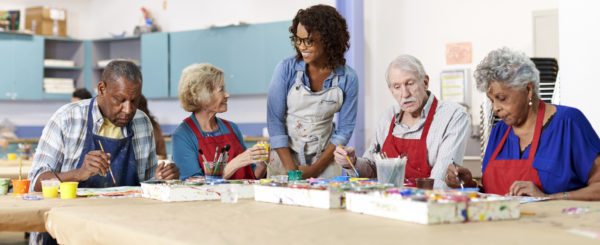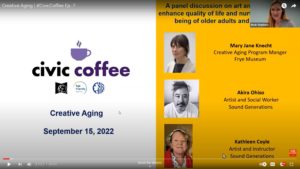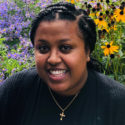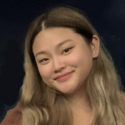Civic Coffee Recap: Creative Aging
 We all know how important it is for older adults to eat healthy food and exercise their bodies, but one thing that is often overlooked is the benefit of art and creativity in everyday life. By stretching our creativity through art, we can find ways to express ourselves, de-stress, and make connections. Regardless of how older adults participate in arts and creativity, it can be a liberating experience that gets people to try something different.
We all know how important it is for older adults to eat healthy food and exercise their bodies, but one thing that is often overlooked is the benefit of art and creativity in everyday life. By stretching our creativity through art, we can find ways to express ourselves, de-stress, and make connections. Regardless of how older adults participate in arts and creativity, it can be a liberating experience that gets people to try something different.
Age Friendly Seattle convened a fascinating group of panelists in September to shed light on art and its power to enhance quality of life and nurture overall well-being of older adults and caregivers. This Civic Coffee featured panelists Mary Jane Knecht, who manages the Creative Aging Program at the Frye Museum; artist Akira Ohiso, who is a social worker with Lake City Seniors; and artist Kathleen Coyle, who teaches art at Lake City Seniors, partnering with Sound Generations. These experts brought diverse perspectives and shared ways to participate in art around our city. Some of their insights are captured in this article, but the full program is well worth a listen here.
About half of the people joining Kathleen’s class for the first time have never experimented with arts before. For many, making art can be intimidating and scary; however, the beauty of making art is that there are no rules. Art gives people permission to express themselves without judgment.
 Kathleen notes that, when people can break through the intimidation and learn that it is ok to make mistakes, they build confidence in making art and build self-confidence. Mary Jane emphasized that art provides people with choices. Oftentimes as people age, they experience less control over life choices. Art is a creative process involving choices that come together to make a piece. Many people will find that diving into art can be a liberating experience.
Kathleen notes that, when people can break through the intimidation and learn that it is ok to make mistakes, they build confidence in making art and build self-confidence. Mary Jane emphasized that art provides people with choices. Oftentimes as people age, they experience less control over life choices. Art is a creative process involving choices that come together to make a piece. Many people will find that diving into art can be a liberating experience.
During the COVID-19 pandemic, we all realized the importance of social connectivity. Art can be a space to build connections and meet new people. To make art, people are often pushed out of their comfort zones to be creative. Akira shared that he sees this reflected in his work: people start to open up to one another and build relationships.
Art can facilitate social connections and be a gateway to community building, both in its making as well as its viewing. Last spring, Akira worked on an art installation—the SLURP! mural—in the Chinatown International District. This art piece was installed as part of efforts to revitalize Maynard Alley and to tell the stories of the Asian immigrant community here in Seattle. It has now become a space where the community holds events and gatherings.
Kathleen also stressed the importance of art in public spaces, as many of her students’ artworks are showcased at a local coffee shop, Kaffeeklatsch. Putting up art in local spaces allows for everyday people to enjoy the work of her students.
Art and creativity can also help people living with dementia to enjoy a fulfilling life. In a culture with so much fear around aging and dementia, Frye Museum has created programs that allow people experiencing dementia and their caretakers to simply be present with art. Frye Art Museum has been a leader in this space and encouraged other museums to think about how they can become more dementia-friendly with art. Whether it is enjoying art or making art, the programs allow for welcoming environments where people do not need prior experience to join.
Mary Jane expresses that once people have a space where they feel welcomed regardless of disabilities, it is surprising to see how it can cultivate rich and meaningful conversations. The museum is also committed to providing free admission and programs to the public, which allows the arts to be accessible to a wider range of people.
All three panelists stressed the importance of investing in local artists. Art and creativity can be seen in many different forms and supporting a range of local artists can help bring these to the public. In such a technology-focused city like Seattle, it can be easy to ignore the artistic elements of the city. Aside from the big tech companies that reside in Seattle, we are also known for our murals and little quirks of artwork around the city, like the Fremont Troll under the Aurora Bridge and the Hammering Man outside the Seattle Art Museum. Investing in artists helps to keep the charm of Seattle and ensure everyone can reap the joy and mental health benefits of art.
While it can be scary and intimidating to take the first step into making and experiencing art, our panelists encourage everyone to give it a shot and discover how art can benefit our daily lives. Regardless of the art form, we are encouraged to be curious and to wonder.
At every age, there will always be potential for new kinds of expressions through art. Many art programs here in Seattle are committed to bringing arts and creativity to older adults in an accessible way. We encourage readers to check out Sound Generations and the Frye Museum for more information on their art programs.
Happy creating!
 Contributors Eldad Mekuria and Ronya Tan are members of the Age Friendly Seattle team. Eldad is a
Contributors Eldad Mekuria and Ronya Tan are members of the Age Friendly Seattle team. Eldad is a  program coordinator, working on loan from The Seattle Public Library. Ronya is an intern providing community outreach and program support. She is a student at the University of Washington.
program coordinator, working on loan from The Seattle Public Library. Ronya is an intern providing community outreach and program support. She is a student at the University of Washington.
![AgeWise King County [logo]](https://www.agewisekingcounty.org/wp-content/themes/agewisekingcounty/images/logo.png)